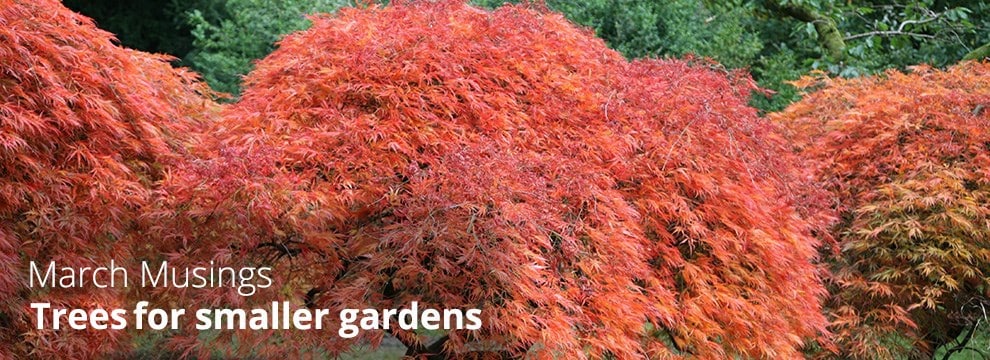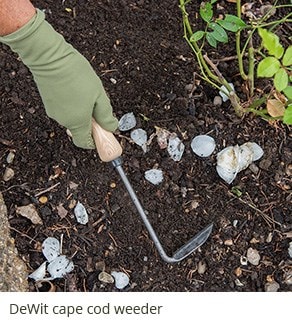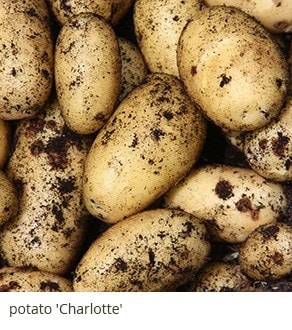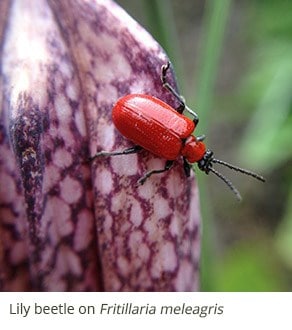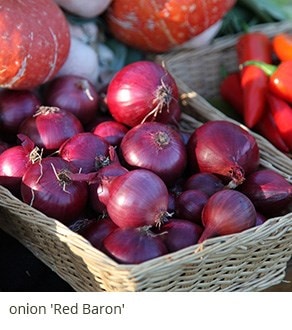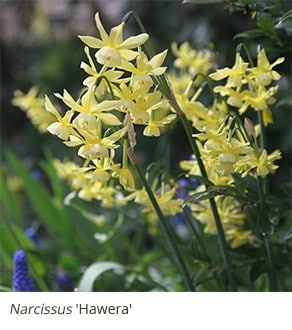|
We’re coming up to the best planting season of the year, so it's a perfect opportunity to add a small, container-grown choice tree to your garden. They’re vital additions because trees add height and scale to the rest of your planting and prevent it from looking like a gaudy carpet. The overhead branches cast a magic lantern pattern of light and shade and this changes throughout the day as the sun moves round the garden. The canopy offers shelter and the roots drain the soil, so many plants do far better under the benign presence of a choice tree. Finally planting a tree helps the environment because they gather up harmful carbon dioxide and emit oxygen into the air. They are literally the lungs of any garden.
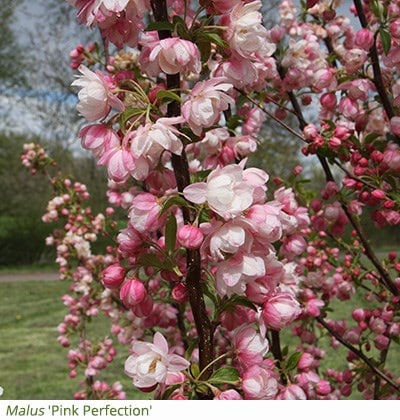
Although this is all very worthy, they will also add a touch of beauty in two, three or sometimes four seasons. It may be flower, autumn colour, attractive bark or a shapely winter silhouette. Even one tree can make a tremendous difference to how your garden looks, for without them gardens are soulless affairs.
These days most of us have relatively small gardens so we have to make careful choices. Chosen trees have to be small and slow growing and they have to be given a place in the spotlight. Never buy a tree and tuck it on a boundary: it needs a prominent position to grow and thrive. Gardeners normally need help to choose a tree because most of us don't get to plant them very often because our gardens are rather modest. We can't aspire to the arboretum of giant trees, but we can all enjoy a fabulous tree or two.
Crab apples (or ornamental Malus) are amongst the most useful small trees because they offer attractive spring blossom that’s capable of cross-pollinating domestic apple varieties. Most produce an abundant crop of small fruits that often persist through winter, or they can make good crab apple jelly. Some have dusky foliage in spring and some offer autumn colour.
Recent Danish breeding has produced a new type of disease resistant crab apple. These were raised by Karsten Jensen, who crossed and selected wild-collected crab apples for over thirty years. They include the sultry Malus toringo 'Aros', which has dark purple-pink flowers that appear just as the purple tinted foliage begins to open. The foliage keeps its dark colour for many weeks, before maturing to dark green. A crop of dark maroon crab apples follow, adding a touch of autumn splendour. This compact variety (some 2.5m/8ft high) has an upright habit so it's perfect for a smaller garden, or for a large patio if grown in a container.
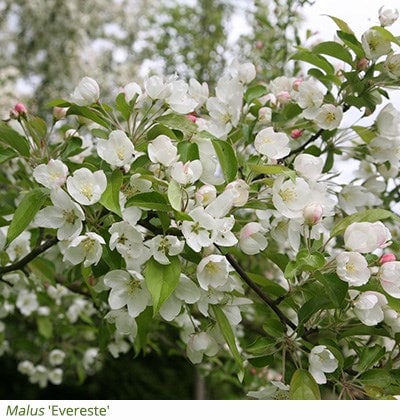 M. torringo ‘Scarlett’, from the same Danish breeder, has deep purple spring foliage and lots of rich pink blossom followed by an abundance of small reddish fruits. It will also reach 2. 5m or 8ft in height and also forms a columnar shape like ‘Aros’. These newly bred crab apples will tolerate heavier soil and chillier conditions, so they will do far better than flowering cherries. These mostly need reasonable drainage in winter, fertile soil and warmer sites. M. torringo ‘Scarlett’, from the same Danish breeder, has deep purple spring foliage and lots of rich pink blossom followed by an abundance of small reddish fruits. It will also reach 2. 5m or 8ft in height and also forms a columnar shape like ‘Aros’. These newly bred crab apples will tolerate heavier soil and chillier conditions, so they will do far better than flowering cherries. These mostly need reasonable drainage in winter, fertile soil and warmer sites.
If you want to go for an even smaller crab apple, Malus ‘Laura’ has bi-coloured pink and white blossom set against dark purple-green foliage. The large, maroon fruits make a superb deep red jelly, or you can leave them as a winter feature. This naturally dwarf tree, reaches a maximum height of 2m (6ft) in 10 years, so it’s ideal for a patio or small garden.
'Appletini' has masses of cherry like fruits that mature to a really bright red. These endure into winter. If you're after lots of pink blossom, rather than colourful fruit, ‘Coralburst’, is smothered in rose-pink buds that open to apple blossom pink. Bronzed fruits follow and this one is a perfect size for a patio. ‘Pink Perfection’ probably has the best blossom of all and the semi-double, fragrant blossom hangs in clusters displaying pink and white. Although not suitable for a patio, this tree is perfect for a small garden because it will only reach 3m or so after ten years.
Flowering cherries come in a variety of shapes and sizes and their blossom can vary from delicate single to heavy skirted ball gown.
Fuji cherries, Prunus incisa, are equally adaptable, but not all are suitable for smaller gardens. The classic ‘Kojo-no-mai’, more shrub than tree, is perfect. The bare branches, which twist and tune, are covered in small white flowers held in pretty pink calices. ‘Kojo-no Mai’ is suitable also for a pot or woodland garden and when grown in a sunny spot, it’s always smothered in spring flowers. When you’re planting a compact tree, underplant it with something low growing like miniature blue muscari, crocus, or low growing woodlanders so that they match the diminutive size of the tree.
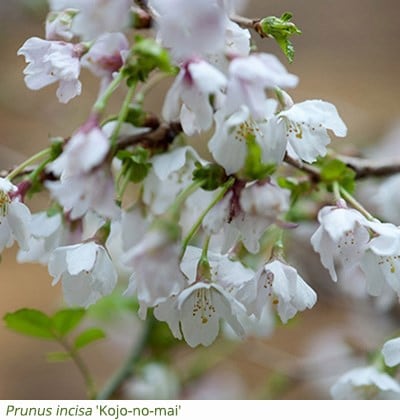
If you want to cast a gentler shade over a woodland patch Prunus serrula, the Tibetan Cherry, has dainty white flowers in spring. In winter the bark looks like polished mahogany so this is often grown in winter gardens. Or you could try the paper-bark Maple, Acer griseum, because this also shines in winter when the sun catches the ragged edges on the cinnamon-brown trunk.
Another tree that shines in winter is the mountain ash, or Sorbus. Most have clusters of berries and delicate pinnate leaves. They grow in well-drained places, often on mountain slopes, so they need careful siting and some aren’t easily grown. One of the most robust is Sorbus pseudohupehensis ‘Pink Pagoda’’, which combines clusters of pink berries with grey tinted foliage. It's particularly good surrounded by pale pink hellebores, such as ‘Penny’s Pink’. The pink berries persist until the hellebores open.
If you're looking for a splash of red on a small weeping tree that forms an umbrella of semi-evergreen foliage, Cotoneaster ‘Hybridus Pendulus’ is very architectural when grown as a standard. This adaptable tree seems to thrive on any soil, like all cotoneasters, and many place a pair close to stone steps, or a gateway. In spring it's covered with white flowers and these are adored by honeybees. Red is an important colour in the winter because it shines out. The medium sized, healthy crab apple, Malus x robusta ‘Red Sentinel’, produces lots of red fruits and these persist through autumn and winter. A scattering of red fruit on a green lawn is a great sight in winter. This is a larger tree that will eventually reach 6m (20 feet) in height.
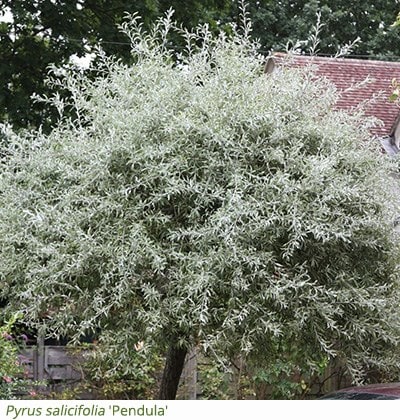
If you want to add a cool splash of sage green the weeping pear, Pyrus salicifolia var. orientalis ‘Pendula’, will mix well with silver leaved plants. It’s often clipped and shaped into umbrellas, although this prevents it producing white blossom. You can also leave it to form a dense tree, or thin out the branches so that they look like the spokes of an umbrella. Whichever you choose, give it a place in the spotlight so that it shines in every season. It’s one of the few silvery looking trees suited to a smaller garden.
If you’ve got a really sheltered special spot for a lovely foliage tree, try Cercis canadensis ‘Forest Pansy’. This forms a multi-stemmed airy shape and the heart-shaped leaves are a deep burgundy. They fade a little after spring, but still retain their port wine colour and they display themselves well. Small flowers do appear in spring, but this is grown for its foliage. There is a variegated form called ‘Alley Cat’ and a weeping form called ‘Lavender Twist’ If you want more spectacular flowers opt for ‘Avondale’ which bears pendent clusters of bright pink flowers just before the leaves appear. The foliage turns butter yellow in autumn. ‘Avondale’ could be grown in a pot, or on a warm wall because all Cercis need a warm position to do well, so they are not for exposed gardens.
These modest trees will all provide a focal point for your garden. Take a little time to prepare a planting hole and make sure that it’s larger than the pot. Add some bonemeal as you backfill and stake for the first year or two - using a tree tie. If deer and rabbits are a problem always add a guard. |



